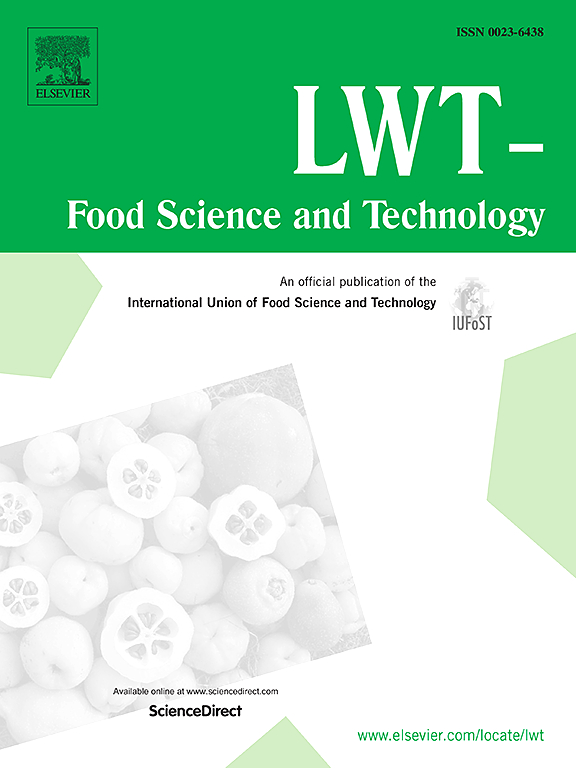Characterization of blueberry (Vaccinium corymbosum L.) catechol oxidases III binding mechanism in response to selected substrates and inhibitors
Abstract
Catechol oxidase (CO) is one of the enzymes that cause browning of blueberries and related products. In-depth study of its properties will help reduce the loss caused by it. The optimal pH for catechol (CAT), 3,4-dihydroxyphenylacetic acid (DOPAC), 4-methylcatechol (4-MeCAT), 3-hydroxytyramine hydrochloride (3-HTH), and pyrogallol (PG) substrates were 6.0, 4.0, 3.0, 6.5, and 4.5, respectively. The substrates with catechol structure selected in the experiment can react with CO, except protocatechuic acid (PCA). Caffeic acid (CA) may be the most suitable natural substrate for this blueberry CO. The K+ and Na+ have little effect on the CO activity. Li+, Mg2+, Cu2+, Zn2+, and Ca2+ could increase enzyme activity at low concentrations (0–5 mmol/L). The most effective inhibitor in the experiment was tropolone (TPL; IC50 = 10.01 ± 0.11 μmol/L), followed by 1,4-benzoquinone (1,4-BQ; IC50 = 34.84 ± 0.56 μmol/L). It was found that the carboxyl or phenolic hydroxyl groups in the substrates and inhibitors played an important role in binding to the catalytic cavity. The position of THR320 (HB1 + 1) was a key in regulating enzyme activity. The sugars should be in high concentration condition to inhibit enzyme activity.

| 公司名称 | 产品信息 | 采购帮参考价格 |
|---|---|---|
| 麦克林 |
3,4-dihydroxyphenylpropionic acid
|
¥23.00~¥3500100.00 |
| 上海源叶 |
1,4-benzoquinone
|
¥18.00~¥61832.01 |
| 上海源叶 |
benzoic acid (BA)
|
¥2605.69~¥60158.31 |
| 麦克林 |
chlorogenic acid
|
¥18.00~¥34032.00 |
| 麦克林 |
catechol
|
¥20.00~¥17361.57 |
| 麦克林 |
3-hydroxytyramine hydrochloride
|
¥20.00~¥15115.00 |
| 上海源叶 |
3-(4 hydroxyphenyl)propionic acid (4-HPPA)
|
¥135.00~¥15002.00 |
| 麦克林 |
caffeic acid
|
¥13.00~¥14616.00 |
| 麦克林 |
gallic acid
|
¥18.00~¥14449.00 |
| 麦克林 |
3,4-dihydroxyphenylacetic acid
|
¥22.00~¥13500.00 |
| 麦克林 |
3,4-dihydroxyphenylacetic acid (DOPAC)
|
¥22.00~¥13500.00 |
| 上海源叶 |
3-phenylpropionic acid
|
¥16.00~¥12491.38 |
| 麦克林 |
4-methylcatechol
|
¥20.00~¥12296.00 |
| 上海源叶 |
4-hydroxybenzoic acid (4-HBA)
|
¥13.00~¥11253.66 |
| 上海源叶 |
benzoic acid
|
¥18.00~¥11251.00 |
| 上海源叶 |
3-(4-hydroxyphenyl)propionic acid (4-HPPA)
|
¥32.00~¥10925.00 |
| 上海源叶 |
4-hydroxyphenethyl alcohol (4-HPEA)
|
¥16.00~¥10311.00 |
| 麦克林 |
pyrogallol
|
¥18.00~¥9227.00 |
| 麦克林 |
protocatechuic acid
|
¥18.00~¥9196.00 |
| 上海源叶 |
ferulic acid
|
¥16.00~¥9006.00 |
| 上海源叶 |
hydroquinone
|
¥10.00~¥7500.90 |
| 上海源叶 |
2,5-dihydroxy-1,4-benzoquinone
|
¥20.00~¥7158.00 |
| 上海源叶 |
2,5-dihydroxy-1,4-benzoquinone (2,5-DH-1,4-BQ)
|
¥20.00~¥7158.00 |
| 上海源叶 |
3-phenylpropionic acid (3-PPA)
|
¥380.00~¥2730.00 |
| 上海源叶 |
l-cysteine (L-Cys)
|
|
| 上海源叶 |
l (+)-ascorbic acid (Vc)
|
|
| 上海源叶 |
ferulic acid (FA)
|
|
| 上海源叶 |
hydroquinone (HDQ)
|
|
| 上海源叶 |
1,4-benzoquinone (1,4-BQ)
|
|
| 上海源叶 |
tropolone (TPL)
|
|
| 上海源叶 |
sodium metabisulfite (SMB)
|
|
| 上海源叶 |
chloranilic acid (CHA)
|
|
| 上海源叶 |
kojic acid (KJA)
|
|
| 上海源叶 |
3,5-dihydroxybenzoic acid (3,5-DHBA)
|
|
| 上海源叶 |
4-hydroxyphenylacetic acid (4-HBAA)
|
|
| 上海源叶 |
3-hydroxybenzoic acid (3-HBA)
|
|
| 上海源叶 |
3-hydroxyphenylacetic acid (3-HBAA)
|
|
| 上海源叶 |
3-(3-hydroxyphenyl)propanoic acid (3-HPPA)
|
|
| 上海源叶 |
phenol (PHL)
|
|
| 上海源叶 |
sodium 4-hydroxybenzoate (4-HBA-Na)
|
|
| 上海源叶 |
sodium benzoate (BA-Na)
|
|
| 上海源叶 |
tyramine hydrochloride (TA-HCl)
|
|
| 上海源叶 |
l -cysteine
|
|
| 上海源叶 |
l (+)-ascorbic acid
|
|
| 麦克林 |
pyrogallol (PG)
|
|
| 麦克林 |
gallic acid (GA)
|
|
| 麦克林 |
3-hydroxytyramine hydrochloride (3-HTH)
|
|
| 麦克林 |
3,4-dihydroxyphenylpropionic acid (DHPPA)
|
|
| 麦克林 |
caffeic acid (CA)
|
|
| 麦克林 |
chlorogenic acid (CGA)
|
|
| 麦克林 |
related metal salts
|
|
| 麦克林 |
catechol(CAT)
|
|
| 麦克林 |
protocatechuic acid (PCA)
|
|
| 麦克林 |
4-methylcatechol(4-MeCAT)
|
 求助内容:
求助内容: 应助结果提醒方式:
应助结果提醒方式:


